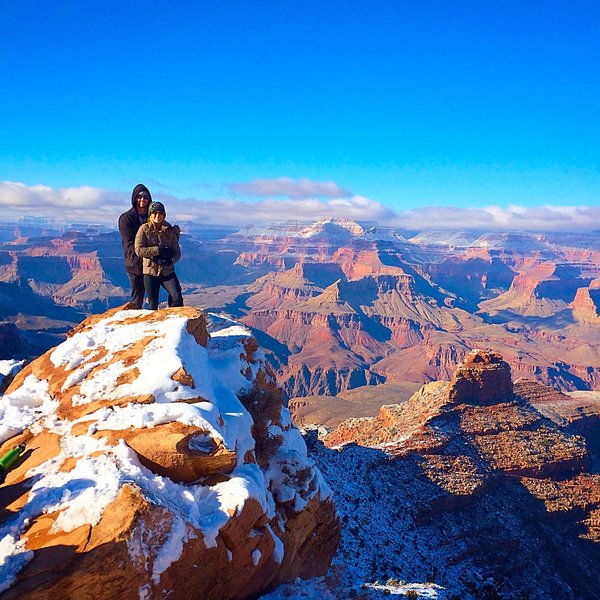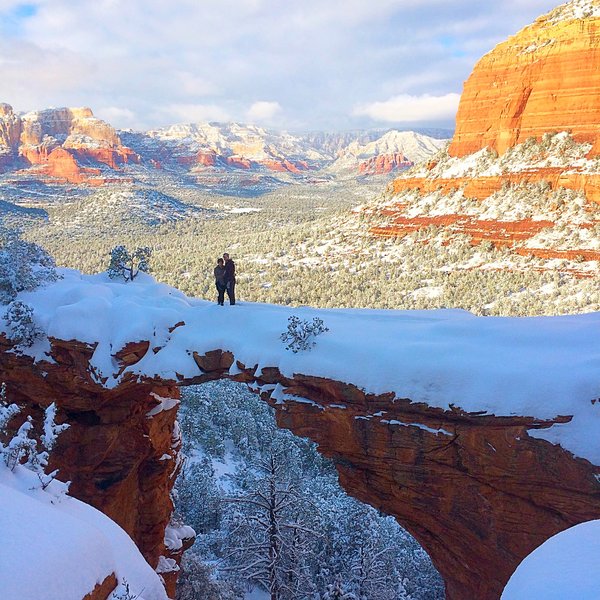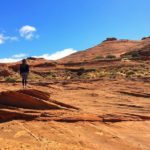Although some people don’t consider the Southwest as being more than desert, Arizona is a state of almost incalculable variety, wide-ranging climate and awesome beauty, rivaling any other place. Canyons, rivers, deserts, mountains, National parks, National monuments and so on and so on.
Where to start? Consider Phoenix for instance . Hiking in Phoenix comprises some of the best hiking in the southwest. Not far from the Valley of the Sun are magnificent canyons and picturesque mountains. We will showcase three incredible Phoenix hiking adventures we highly recommend. These hikes are all within an hour’s drive of Phoenix.
First up: Devil’s Canyon .
1. Reflections On Devil’s Canyon
We rappelled down into the heart of this still wild canyon. Devil’s Canyon is also known as Gaan (Spirit) Canyon because the Apache people, who have occupied this place for over 500 years, consider it sacred. As we descended 60 feet into Arizona’s largest plunge pool, it is easy to see why. Just to the left of us stood a spring-fed waterfall, spilling its precious cargo into the gorgeous pool below. The view from atop a few moments earlier was breathtaking, inspiring awe.
The canyon was resplendently green and dazzling in the late afternoon sun. Sheer cliffs appeared timeless, revealing precipitous vertical boundaries made up of hundreds of rhyolite hoodoos. Palo Verde trees, saguaros, barrel cactus and other quintessential Sonoran Desert vegetation flourished in the reddish brown rock flanking the canyon. Like an ancient temple, this ageless wonder is a reminder of man’s essential fragility in the face of awesome force.
Check out this cyber journey of a trek through Devil’s Canyon:
Devil’s Canyon can be explored via a splendid five-mile roundtrip hike, for those who prefer not to partake in a thrilling, but technical canyoneering adventure.
Before we reached the Seven Sacred Pools which comprises the technical portion of the canyon, the scene was more sylvan and soothing. The riparian forest canopy was so dense that sunlight rarely touched the ground. Canyon Tree Frogs hopped about, blue gills raced through cool dark pools, and there was a rich assortment of birds including red-tail hawks, canyon wrens and ravens.
Set amidst the blazing desert, the inviting paradise of Devils Canyon is second to none. However, a foreign-owned mining company called Resolution Copper, who operate a mine at Oak Flat in the vicinity of the canyon, wants to expand their operations. Gaan Canyon and environs are threatened by a proposed land swap which would allow Resolution to extract ore from 7,000 feet below the surface, destroying the water table and the rich biodiversity that exists within its realm. The mine’s operation would also cut-off access for hikers, climbers, canyoneers, birdwatchers, and all who treasure this area. The local nonprofit organizations (Queen Creek Coalition and Friends of Queen Creek) have been organized to help preserve the area, but the mine continues to garner support from Arizona legislators, including the governor.

The site planned for mining is precious for its beauty as well as its history. The name of Apache Leap, a precipitous cliff adjacent to Devil’s Canyon, comes from an event which took place back in the nineteenth century, when Apache families threw themselves off the cliffs to avoid capture by U.S. troops.
It is absurd that Devil’s Canyon and environs can be destroyed so that a company could extract copper, which in any case is unlikely to be in short supply. Instead of destroying it, we should make the canyon and Oak Flat a National Monument.
How to help: Please send a letter to the President about why you oppose the land swap and why you believe Oak Flat and Devil’s Canyon should be protected. The president can use his authority, due to the Antiquities Act, to protect places of great beauty or historical significance. We also encourage you to contact Raul Griljalva who opposes the land swap and tell him how much you appreciate his dedication to supporting conservation in the southwest, and for upholding a Presidential Order that goes back to 1955.
For more information about this issue, Arizona Highways recently published an excellent article in their June 2016 issue, The Battle for Oak Flat , representing the San Carlos Apache point of view of this area’s wealth of spiritual, cultural and environmental significance. It is a worthwhile read.
Let’s do our part to preserve the amazing Devils Canyon, an ecological jewel in Arizona’s Sonoran Desert!
Up Next: The Grand Canyon of the Sonoran Desert: Aravaipa
2. Aravaipa – The Grand Canyon of the Sonoran Desert
Now we shift our attention to The Grand Canyon of the Sonoran Desert: Aravaipa.
Canyons are Arizona’s magnificent cathedrals, and Aravaipa is one of its greatest examples. Red rock walls are thrust upward in intricate patterns; they form ancient geologic sculptures which appear timeless. Open to the sky, the sheer cliffs are continuously altered by sun rain, wind and snow. Deep within the heart of these stony estates, calm and quiet reign. This is Aravaipa Canyon, a stunning 12-mile gorge located between Phoenix and Tucson.
Aravaipa is one of the finest places to hike and backpack in the Southwest. The BLM strictly regulates the number of hikers visiting the canyon. Aravaipa is a protected riparian area; it features a perennial stream, towering canyon walls, lush vegetation, and lots of wildlife. For much of its length, Aravaipa Creek wanders along the bottom of the canyon, flanked by multicolored cliffs, some of which tower 1,000 feet above the canyon floor.
What makes Aravaipa so unique are its beautiful wilderness characteristics, including the lack of any well-defined trails. Throughout the hike the stream accompanies the hiker. The wilderness is a rare example of what happens when water flows through an-arid environment. Besides stunning scenery, we travel there during the first week of December for fall color. Aravaipa in autumn is magical, and a trip there in autumn is a voyage into the essence of the season. Blazing cottonwoods, willows, ash and sycamore vie for one’s attention with the painted canyon walls.

As we hiked further the canyon walls rose higher and the stream crossing became more numerous. Aravaipa is just as much about the sound of water as it is the brilliant scenery. Part of the uniqueness of Aravaipa Canyon is hiking through shallow water ranging from ankle to knee deep. Five-Ten Canyoneering boots and neoprene socks make for perfect footwear for splashing your way through the creek: Aravaipa is an Apache name which means “laughing waters.” The stream is brisk and clear and cascades around boulders, gravel bars and plunges into pools.
The cavernous, buff colored walls you see as you walk through the east part of the canyon are Hell Hole Conglomerate, which extends quite a way downstream. Continuing west, the Galiuro Volcanic rise up and shape many of the side canyons. This mid-portion of Aravaipa Canyon displays impressive red, orange, and gray walls with columns towering over 1,000 feet. We enter a splendid side drainage; the name belies the nature of this winding tributary gorge. Cut from the buff colored rock, Hellhole Canyon is a wonder to behold. The view around each bend becomes increasingly superb; beautiful fall foliage is present throughout this glorious slot canyon.
We round yet another bend, past the gushing spring on the left. This side gorge, with its lush hanging gardens, springs and deciduous trees is a delightfully cool sylvan oasis in the midst of the Sonoran Desert. Hellhole’s ecosystem includes monkey flowers, maidenhair ferns, columbine, Arizona Walnut, Ash, and Sycamore; a wonderful riparian habitat.
Then we heard it, the granddaddy of all hanging gardens! On the right stood this weeping cascade pouring from the rock wall, resembling rainfall. The scene was more reminiscent of Costa Rica than the desert southwest. I threw down my day-pack and sat behind the waterfall, mesmerized. After more than a dozen trips to this canyon, I was delighted to still be discovering new sights of interest in this most hallowed of ground.
Edward Abbey, the famed western writer, summed it up elegantly:
“It seems to me that the world is not nearly big enough and any portion of its surface, left unpaved and alive, is infinitely rich in details and relationships, in wonder, beauty, mystery, comprehensible only in part. The very existence of existence is itself suggestive of the unknown – not a problem but a mystery. We will never get to the end of it, never plumb the bottom of it, never know the whole of even so small and trivial and useless and precious a place as Aravaipa. Therein lies our redemption.”
Check out this four-minute video called “I Am Aravaipa”.
3. Salome Jug – A Thrilling Canyon Adventure!
Salome Jug is a truly thrilling canyoneering journey, one of the best treks in the state and within 60 miles from Phoenix. Situated in the Sierra Ancha Mountains, rushing water has carved a spectacular gorge cut through pink granite. Salome Canyon is one of the most awesome canyoneering hikes in Arizona. Trekking the Jug is akin to partaking in one of nature’s grandest water parks. Turn up your speakers and enjoy this short video!
Canyoneering is the fastest growing alpine sport in the United States and for good reason. An experienced canyon enthusiast can access and encounter amazing and remote places seen by only a few. Salome Jug is such a place.
To safely descend this canyon, you’ll need a 100-foot rope, a harness, helmet, caribiners, quick links and webbing. Wear boots with good traction and wetsuits come in handy in all but the hottest weather. Or, you can experience this amazing canyon accompanied by a qualified guide or tour company. The full descent of Salome Jug takes about five hours and is a sublime journey indeed. And, as we said, one of the best Phoenix area hikes you can experience.

The waters of Salome gather in the Sierra Ancha Mountains of central Arizona. Just before the creek merges with Roosevelt Lake, it cuts an impressive gorge; slicing through ancient granite like a knife. The trek itself is a combination of hiking, boulder hopping, wading, swimming and rappelling. Because of its technical nature, you need to be proficient in canyoneering and give the canyon the respect it deserves. Going with more experienced canyoneers or a guide is recommended; the consequences for the unprepared can be serious. However, for the experienced, there are few canyons which offer a greater effort to reward ratio. The scenery is stunning, the swimming refreshing and the experience sublime.
 South Kaibab Trail | Grand Canyon, AZ
South Kaibab Trail | Grand Canyon, AZ

